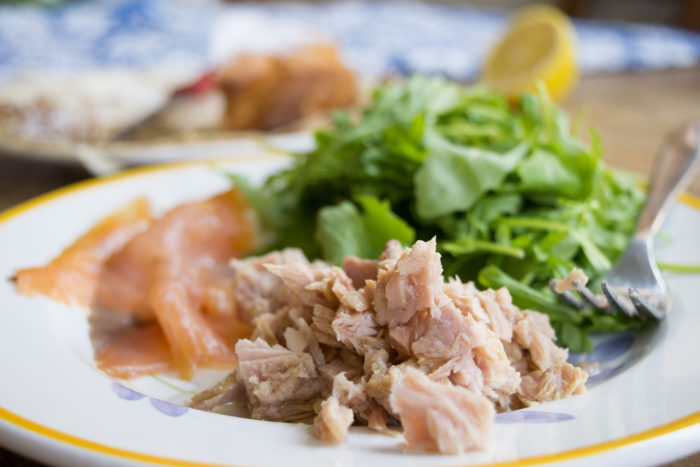Do you know the many benefits of including seafood in your diet? Keep reading to learn more!
When we think of superfoods our minds tend to go towards things like kale, microgreens, green tea, eggs, and yes, even liver.
But seafood is an exceptionally nutrient-dense food that also happens to be a great source of protein. And it certainly deserves a top spot on the superfood list.
Seafood offers very different benefits than other land-animal sources of protein.
Because of this, it should be a regular staple in your diet, along with more common sources of protein like chicken and beef.
But purchasing and preparing seafood can be slightly intimidating. And there’s always the concern of the mercury content of the fish you’re eating.
Many people avoid making seafood a staple in their otherwise exceptionally healthy real-food diets, simply because they’re uncertain how and where to begin.
In this blog post, I’m going to break down some of the biggest barriers that keep people from eating more seafood.
Keep reading if you want to learn:
- The nutritional value of seafood that elevates it to superfood status
- How eating seafood can benefit you
- What you should do about the mercury content of seafood
- Tips for making seafood a staple in your diet
If you’re ready to take your seafood game to the next level, let’s go!

Nutrition in Seafood
The nutrition profile of seafood is drastically different from any other food you can consume. You’ll find certain vitamins and nutrients in seafood that you just can’t get from any other food in similar quantities.
This makes seafood an important component in a well-rounded, real-food diet.
Here are some of the most valuable nutrients that you’ll find in most seafood.

A Superior Source of Protein
The protein found in seafood is more easily digested than the protein in beef, pork, or chicken.
This is likely due to the increased bioavailability of the amino acids (compounds that make up protein) found in seafood as compared to other meats.
Essentially, the protein in seafood is easier for your body to use than the protein found in chicken or beef.
Seafood also contains a balance of all the essential amino acids. This makes it a complete protein source, and one that your body can use for all its protein requirements.
The seafood with the highest protein content per ounce are options like tuna, anchovies, salmon, and trout.
Including these superfoods in your meals can help give you a boost of usable protein. This protein will serve as building blocks for many essential processes in your body.

Full of Beneficial Omega-3s
Seafood is also rich in the long-chain Omega-3 fatty acids DHA and EPA.
These anti-inflammatory compounds are more readily usable by our bodies than their short-chain counterparts. Short-chain Omega-3s are found in foods like flax, chia, and walnuts.
Short-chain Omega-3 fats need to first be converted into DHA and EPA to be usable by your body. But the Omega-3 found in seafood is ready and available in large quantities for your body to use.
The Omega-3 fatty acids in fish are critical in supporting healthy hormone production, brain function, cardiovascular health, and so much more.
The seafood with the highest Omega-3 content per ounce is fish like mackerel, salmon, sardines, and anchovies.
Oily fish tend to have larger quantities of Omega-3s than other varieties. So if boosting your DHA and EPA consumption is your goal, aim to consume more oily seafood.

One of the Few Food Sources of Certain Nutrients
When it comes to food sources of essential nutrients like vitamin D, selenium, and iodine, seafood just can’t be beaten.
Iodine and selenium are nutrients that are critical for supporting healthy thyroid function. These nutrients are found in higher quantities in seafood than in most other foods.
Many real-food diets eliminate commercially iodized table salt – which tends to be our primary source of iodine in the west. But by eating seafood regularly you’re ensuring that you’re still getting this essential nutrient and in a purer, more bioavailable form.
The increasing concern of sun exposure causing skin cancer has drastically reduced our Vitamin D levels in recent years. And while there’s no need to shun the sun, including dietary sources of this vitamin, like seafood, can help maintain adequate levels and keep you from becoming deficient.
Vitamin D is necessary for mineral absorption, bone strength, regulating key components of the immune system, and so much more. To help boost your Vitamin D levels you’ll want to focus on consuming seafood like salmon, herring, sardines, and oysters.

The Benefits of Seafood
Now that we know the nutritional value of seafood, let’s dig into how that nutrition can benefit our bodies. The benefits of seafood are far-reaching, and definitely make this food group deserving of the title of “superfood.”
Here are just a few of the ways that consuming seafood regularly can help support your overall health and wellbeing.

Seafood Benefits Your Hormones
As women, our hormones are extremely complex. Because of this, hormone health is often a hot topic with many of the women in my free Facebook community.
We’re so often tempted to reach for a supplement as a quick fix for our hormone problems. But the truth is that increasing our seafood consumption is a good first step to improving hormone health.
Fat is an essential building block for our hormones. Without the consumption of healthy dietary fats, we cannot have healthy, thriving hormones. And seafood just happens to be one of the best sources of highly usable, healthy Omega-3 fats.
The EPA and DHA found in high quantities in seafood, especially oily varieties, can help balance and regulate your body’s hormone production.
Consumption of Omega-3 fats can also help reduce the insulin resistance that often accompanies hormone-related disorders such as PCOS and Diabetes.
If you’re struggling with either of these conditions, try increasing your intake of seafood as a supplement to your current treatment plan.
Seafood for Fertility and Pregnancy
Regular seafood consumption can be extremely beneficial in all aspects of fertility, from preconception through birth.
A diet that contains plenty of Omega-3 fatty acids, like those readily available in seafood, has been shown to support the health and longevity of women’s eggs.
And the same can be said for the relationship between Omega-3 consumption and men’s sperm quality.
If you and your partner are thinking about becoming pregnant in the near future, you can both give your fertility a boost by consuming seafood a few times a week.
And once you do become pregnant, there are still plenty of benefits to keeping seafood as a regular part of your diet.
The Omega-3s found in seafood, especially DHA, help boost your baby’s brain development. Incredibly, one study showed maternal intake of DHA was linked to having children with higher IQ scores!
If you didn’t eat seafood or aren’t currently eating it while pregnant, don’t worry. These results should be taken more so as evidence that maternal nutrition status can impact the health of her baby.
And eating a well-rounded, diet consisting of mainly real foods will provide plenty of nutrition and nourishment for your growing baby!
Plus, you can start consuming more seafood now if you’re still pregnant or even feed your toddler seafood for many of the same benefits.

Seafood Benefits Your Brain
Like your hormones, your brain and nervous system rely heavily on fat for their health and longevity.
The Omega-3 fats found in seafood benefit your brain by helping to build stronger membranes around brain cells.
These membranes are critical in improving the structure and functioning of the neurons that transmit signals that enable your brain to think!
Regular DHA consumption, one of the main sources of fat in seafood, has been shown to help improve memory and reduce your risk of developing Alzheimer’s disease.
Besides its Omega-3 content, the Selenium found in seafood is also an important nutrient when it comes to brain health. Selenium helps to protect the brain against the oxidative damage that comes with normal aging processes.
In the body, selenium produces special proteins called selenoproteins. These proteins are involved in many brain functions including motor performance, coordination, memory, and cognition.
If you’re looking for dietary ways to boost brain health increasing your seafood consumption is a great place to start!

Seafood Benefits Your Gut
Normally when we think of improving our gut health, we think of consuming foods like bone broth or prebiotic veggies.
But did you know consuming seafood can also have a great impact on the health of your gut?
Omega-3 intake has been shown to improve the diversity of the beneficial bacteria in our gut, and even increase levels of the important Bifidobacterium and Lactobacillus strains.
These Omega-3 fatty acids are also anti-inflammatory and can help to reduce gut inflammation.
Gut inflammation can be a root cause of many gut-mediated conditions like intestinal permeability or even food sensitivities. Plus the Vitamin D found in seafood can also help to enhance your gut barrier function.
Would you like to save this post?
Your email address is 100% safe and will never be sent spam.
If something as simple as eating more seafood can give you a leg up on reducing gut inflammation, you might as well give it a shot!
Eat the Scales, Too
If you’re brave enough to eat skin-on fish with scales, like sardines and anchovies, you’ll actually be consuming chitin – a beneficial prebiotic fiber, essential for gut health.
Prebiotics are mostly found in plant foods and are what feed our beneficial gut bacteria. But, the wider variety of prebiotics fibers you consume, the more diverse your gut microbiome will be.
The prebiotic fiber found in fish scales is not the same as the fibers found in prebiotic plant foods.
By eating those fish scales, you’re helping to increase the diversity and overall health of your beneficial gut bacteria.
A diverse and healthy microbiome is one that will better be able to fight off pathogenic infections, keep your immune system running smoothly, and help your digestion function normally.
Now, don’t expect consuming more seafood to improve your gut function overnight. But along with other dietary and lifestyle interventions, eating more seafood can be a great tool to benefit your gut health and overall wellbeing.

Seafood Benefits Your Skin
If you’re dealing with dry, irritated, or acne-prone skin consuming more seafood could give your skin that boost you’ve been looking for!
Skin cell growth and repair is highly dependent on the availability of the long-chain essential fatty acids DHA and EPA, found in great quantities in seafood.
Consuming seafood a few times a week can help increase levels of these skin-nourishing fats and help get you on your way to having healthier skin.
The anti-inflammatory nature of the Omega-3 fats found in seafood can also be highly beneficial for your skin health.
Inflammatory skin conditions like eczema, psoriasis, and even acne can benefit from the consumption of more high-quality seafood and Omega-3 fatty acids in general.
Plus, these Omega-3 fats can actually make your skin less sensitive to the sun’s damaging UV rays. A win-win for skin health in my opinion!

What About the Mercury Content of Seafood?
We’re often told to limit our seafood consumption to a few portions a week, especially during pregnancy.
The main reasoning behind this belief is the idea that seafood contains high levels of mercury. And when we consume mercury in excess, we can end up with adverse health effects.
However, in reality, the high levels of selenium found in seafood naturally protect against mercury poisoning from seafood consumption.
Selenium binds to the mercury in the fish and makes it so the mercury is not easily absorbed by our bodies.
Certain types of seafood, like swordfish, shark, marlin, king mackerel, and tilefish do contain more mercury than selenium. To avoid excess mercury intake, you should limit or avoid consuming these fish on a regular basis.
But any fish that has higher selenium than mercury content is generally safe to consume.
These safer varieties of seafood, that contain more selenium than mercury, include:
- Shellfish
- Salmon
- Crab
- Shrimp
- Trout
- Herring
- Haddock
- Pollock
- Flounder
- Lobster
These are all great options for including seafood in your diet without fear of mercury toxicity.
(Of course, you should always consult with a doctor or dietitian when attempting a dietary change like increasing your seafood consumption.)
Increasing your intake of selenium is another way to counteract any excess mercury that could be consumed with seafood. You can do this through other dietary sources like Brazil nuts, or with supplementation.
But when you consume the mercury-safe fish listed above, the benefits of regularly consuming seafood outweigh the potential risks of mercury accumulation.

Tips to Get More Seafood in Your Diet
With all of the clear benefits that consuming more seafood can offer, you’re probably wondering how you can get started adding more of this superfood into your diet.
Purchasing and cooking seafood can be intimidating – especially if you’ve tended to steer clear of it in the past. Not to mention the cost of buying seafood can be a deterrent for many people. And if you don’t know how to cook it, fish and seafood can be a little rough on the tastebuds.
But with a little practice, intentionality, and creativity, you can make seafood a staple in your diet!
Here are a few tips for including more seafood in your diet.

Opt for Frozen Seafood
Fresh seafood can be expensive. So instead of forgoing seafood altogether, opt for frozen fish instead of fresh.
Buying fish from the freezer can save you a few dollars per pound, depending on where you purchase it from.
And frozen seafood has the same nutritional benefits as fresh seafood – and sometimes even more.
If the fish was frozen immediately after it was caught, as it often is, the nutrients are kept intact much better than if the fish was kept fresh through the distribution cycle.
Freezing seafood will change the texture of the final product slightly. But this shouldn’t be a deterrent to consuming more of this superfood.
Frozen seafood still tastes great. And if you prepare it with your favorite sauce or seasoning blend, you probably won’t even be able to tell the difference!

Don’t Forget About Canned Fish
Canned seafood, like wild-caught tuna, salmon, or sardines, has similar nutritional value as their fresh counterparts.
Eating fish out of a can may remove some of the allure of eating seafood. But purchasing it in this form will save lots of money. Plus, canned seafood can be just as tasty as if you bought it fresh.
And when you buy bone-in fish like canned sardines or canned salmon, you get the extra benefit of a mega-dose of calcium, which can be hard to find on a dairy-free diet. (Check the can to make sure the bones are included, since many varieties of these fish are boneless.)
Try making a tuna melt for lunch, or sprinkling canned salmon or sardines over a salad. I love mixing canned fish with a healthy mayo and some chopped celery, and then dipping crackers in for a snack or quick lunch.
Canned seafood can be a quick and easy way to give your lunch a giant nutritional boost, all for a fraction of the cost of fresh seafood.

Buy Wild Caught When Possible
When purchasing meats like chicken and beef, we know that grass-fed and organic meats are the way to go.
But seafood doesn’t use those traditional distinctions reserved for land animals. So it can be a bit confusing to know what seafood is going to be the best for your health.
When it comes to seafood labeling, you’ll generally see two options: wild-caught or farmed.
Buying wild-caught seafood is the best equivalent to purchasing organic, grass-fed pastured animals. While farmed seafood is going to offer similar quality as conventional meat.
Farmed fish can have lower nutritional value than it’s wild-caught counterparts, as well as be fed a diet consisting of soy, corn, or other potentially genetically modified grains.
Seafood that has been farmed is also often higher in toxins, antibiotics, and other chemicals than wild-caught fish.
Wild-caught seafood is going to be slightly more expensive than farmed. But, the extra cost is worth it if eating seafood for its nutritional benefits is important to you.
My absolute favorite resource for high quality, sustainably caught fish is Vital Choice. They ship nationwide and have a great selection of delicious, high quality seafood. They are able to capture the fresh-caught quality of delicious, sustainably harvested Alaskan salmon and northwest Pacific seafood by cleaning and flash-freezing it within hours of harvest.

Simple Ways to Cook Seafood
Purchasing seafood is one thing, but trying to figure out a way to cook it and actually make it taste good can be a whole different challenge.
My favorite way to cook seafood is to simply add a sauce or seasoning blend and sauté it in a pan until it’s done.
But if you’re looking for some tried and true seafood recipes to get you started, here are some good ones:
- Smoked Salmon and Beet Salad
- Tossed Tuna Nicoise Salad
- Lemony Sardines on Toast
- Salmon Salsa Salad
- Cajun Fish with Green Beans and Sweet Potato Wedges
- Roasted Salmon and Quinoa Salad
- Tropical Salmon with Sweet Potato Mash
- Paleo Crab Cakes
- Paleo Shrimp Scampi with Zucchini Noodles by Paleo Running Momma
- Pan-Seared Scallops with Cauliflower by Paleo Leap
- Easy Sheet Pan Maple Mustard Salmon & Veggies by Paleo OMG
- Leon’s Caper and Anchovy Miracle Sauce by Nom Nom Paleo
- Seared Ahi Tuna with Chimichurri Sauce, Arugula, and Avocado by Kitchen Confidante
- Coconut Crusted Salmon Bites with Sweet Chili Sauce by The Endless Meal
- Crab Cakes with Roasted Red Pepper Sauce by I Breathe, I’m Hungry
- Chargrilled Squid with Rustic Guacamole by Jamie Oliver
- Cauliflower Shrimp and “Grits” by Wicked Spatula
- 15-Minute Spicy Mussel Soup by Cook the Story
Try out one of these simple recipes, tag me @lauraschoenfeldrd on Instagram and let me know how you liked it!

The Bottom Line on The Benefits of Seafood
Seafood is packed full of essential nutrients that you can’t find in many other food sources.
The benefits of including more seafood in your diet are numerous. Everything from your gut health to the health of your skin can benefit from eating more of this superfood.
To get the most bang for your buck, focus on oily fish like salmon, sardines, and tuna. These varieties of seafood contain the highest concentration of healthy Omega-3 fats.
Don’t forget that variety is important too! And don’t hesitate to stretch outside your seafood comfort zone. Try experimenting with cooking mussels, scallops, or even squid.
You might just stumble across a new favorite food or go-to dish.
And you’ll be fueling and nourishing your body. Not just by introducing new foods into your diet, but also by giving yourself the freedom to experiment and find what truly fills you up, body, mind, and spirit.
What did you learn about the benefits of seafood from reading this article? Are you going to try including more of this superfood in your diet? Share your thoughts in the comments below!
This post may contain affiliate links. If you click on a link and make a purchase, I may receive a small commission.

+ show Comments
- Hide Comments
add a comment